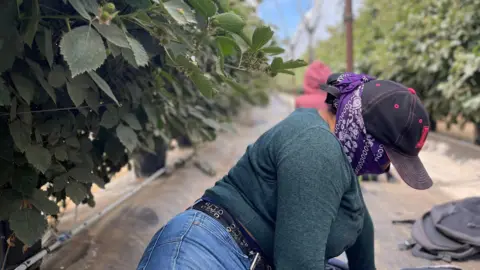The article titled “Hiding in the fields – farm workers fearing deportation stay in California’s shadows” dives into the experiences of undocumented workers in California, particularly in Oxnard, where fears of immigration raids have caused significant distress among the agricultural labor population. This situation is primarily driven by recent intensified operations from the U.S. Immigration and Customs Enforcement (ICE), which has executed raids on farms in the area, causing numerous workers to feel unsafe.
The narrative begins by introducing a group of women laborers who are crouched down in the fields to avoid detection by ICE. One such worker, wearing a hat and a purple bandana over her face, questions a reporter to confirm they are not affiliated with ICE, highlighting her palpable fear and anxiety. This individual, originally from Mexico, conveys the tense climate of insecurity faced by many like her who have relocated to the U.S. to work in agriculture, which is largely centered around berry picking—a key industry for Oxnard, known as the “strawberry capital of the world.”
The anxiety felt by these workers is emphasized by reports of ICE officials raiding nine farms in the vicinity, where they arrested around 35 individuals, mainly targeting those who were not on the farms at the time. Realizing the risk posed by their presence, many workers have opted to conceal themselves in the fields rather than risk being apprehended. The fear of eviction from this economic opportunity heightens as the context shifts towards the political dynamics surrounding immigration under President Donald Trump’s administration, which has made efforts to increase deportations dramatically.
As the article reveals, the recent pattern of raids that target immigrant communities in places like Oxnard reflects Trump’s pledge to deport undocumented individuals, a measure that initially found traction with various demographic groups. However, the backlash observed in larger urban areas like Los Angeles reveals a more divided public opinion about such actions, leading to protests and unrest in response to the crackdown.
The narrative poignantly illustrates the difficulties these workers face not merely from the reality of potential deportation but also the everyday implications on their lives. The interviewed worker expressed her distress about being treated as a criminal for simply seeking improved living conditions and has shared her hopes of reuniting with her children left back in Mexico. The consequences of these operations are not limited to the agricultural sector alone; businesses that depend on farm workers, such as restaurants, are experiencing downturns as fear keeps clients away. Raquel Pérez, a restaurant owner, notes a sharp decline in customers and expresses concern over the wider economic impact due to diminished agricultural labor.
The escalating fear among farm workers has also raised concerns about the sustainability of food supply chains in the U.S., given that more than 40% of the nation’s farmworkers are undocumented. With many hesitant to report to work or access necessary services amid the intensified scrutiny from ICE, a ripple effect is observed across various economic sectors. The article underscores the increasing prevalence of agricultural raids and their implications—not only do they endanger migrant workers but they also disrupt critical supply chains, potentially leading to shortages of fresh food.
In conclusion, the experiences captured in this article demonstrate a prevailing climate of fear among undocumented farm workers in California, driven by the actions of ICE and the rhetoric surrounding immigration policy under the Trump administration. The farmers and businesses reliant on these workers are also beginning to understand the long-term consequences that such enforcement measures could have on their livelihood, highlighting the complexities of immigration enforcement in the agricultural sector. The interconnectedness of labor, business dynamics, and the legislative landscape reveals a truly intricate web where the lives of migrant workers and the economy are inextricably linked.



